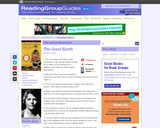
This resource contains a set of discussion questions for The Good Earth by Pearl S. Buck
- Subject:
- English Language Arts
- Material Type:
- Activity/Lab
- Provider:
- The Book Report Network|Reading Group Guides
- Date Added:
- 03/29/2017

This resource contains a set of discussion questions for The Good Earth by Pearl S. Buck

In this lesson students are ask to explore ideas using examples of great writers with a particular focus on William Shakespeare. In the Introductory Activity, students look at several authors to begin identifying ways in which authors' lives are reflected in their writing. In the Learning Activity, students watch videos segments from the PBS series and explore the question of whether or not events in Shakespeare's life influenced his plays. Finally, in the Culminating Activity, students examine text from The Tempest to assert whether or not Prospero's speech from Act V, Scene 1 was in fact Shakespeare's farewell to the theatre.
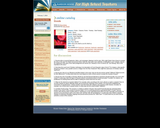
This Random House for High School Teachers reader's guide includes questions to explore Dracula, Bram Stoker’s hypnotic tale of the bloodthirsty Count Dracula, the quintessential story of suspense and horror.
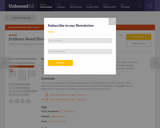
In this lesson based on Poe's The Tell Tale Heart, students will explore the first two paragraphs and analyze how Poe develops the central ideas of obsession and madness through specific textual details.
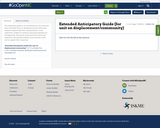
This anticipatory guide is an introduction for any units that have a thematic focus on displacement and community. Students respond with their initial positions on the statements. Evidence is based on personal experience at the beginning. They return at the end of the unit to the statements and provide evidence from the texts in the unit to support their responses.

This resources contains discussion questions for Fahrenheit 451 by Ray Bradbury.
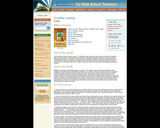
This Random House for High School Teachers reader's guide includes an introduction, questions, and suggestions for further reading designed to enhance discussion of J. California Cooper's book, Family.
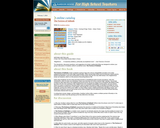
This Random House for High School Teachers reader's guide includes an introduction, discussion questions, author biography, and suggested reading list designed to enhance student reading of Jonathan Lethem’s acclaimed coming of age novel, The Fortress of Solitude.
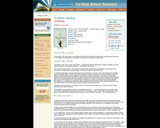
This Random House for High School Teachers reader's guide includes questions, discussion topics, and suggestions for further reading intended to enrich student discussion of Jonathan Odell's novel, The Healing, a warmhearted novel about the unbreakable bonds between three generations of female healers and their power to restore the body, the spirit, and the soul.
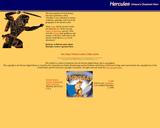
This online digital exhibit provides pertinent information on the epic hero, Hercules. The site contains a bio, myths, other notable characters, and documentation of the twelve labors of Hercules. There are also pertinent links provided for further study of Greece and the epic hero.
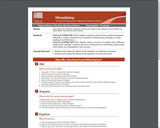
Learn about the Hiroshima explosion and how the height of the explosion and its effects are linked. Book: Hiroshima by John Hersey
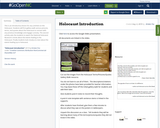
This is an introductory lesson for any unit/text on the Holocaust. Students will first gallery walk various pictures, terms, and quotes about the Holocaust to connect with any previous knowledge and engage curiosity. The second activity asks the students to watch the National Holocaust Museum's movie about the events leading to the Holocaust. Finally students look closely at a text about the events leading up to Holocaust.

This webpage contains theme-based discussion prompts for each vignette in The House on Mango Street by Sandra Cisneros, as well as a selection of follow-up activities.
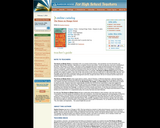
This guide to The House on Mango Street by Sandra Cisneros contains an overview of the book and author, discussion and writing prompts for comprehension, language, characters, and themes, and follow-up activities to extend learning.

In the TED Ed lesson focused on Dracula and vampires, students will explore the evolution of the vampire over time, from a symbol of disease in its original conception, to Bram Stoker's Dracula, and its incarnations in current pop culture. Students will discuss and consider why the vampire is important as a symbol today. Discussion questions and additional resources available in the sidebar.

Students examine the steps involved in the basic analysis of literature. Then, using a well-known fable, students go through each step of analysis (comprehension, interpreting, and drawing conclusions).

In the TED Ed lesson focused on dystopian literature, students will explore the popularity of modern dystopian fiction and discuss what it might tell us about the preoccupations of our society. Discussion questions and additional resouce links included in the sidebar.
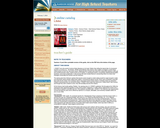
This teachers guide includes summaries of each part of the book I, Robot, by Isaac Asimov, as well as discussion questions for students and suggested activities.

In this video resource from PBS Learning Media, students will explore the types of humor that exist, such as Irony, Satire, Farce, and Parody. They will research and find examples of humor that appeal to them. Next, they will choose a passage written by Mark Twain and analyze it to determine what type of humor is used.

A teachers guide for Robert Fitzgerald's translation of The Iliad by Homer, including background information, advice for approach, questions for basic comprehension for each book, questions for further study for each book, and ideas for activities to deepen understanding.